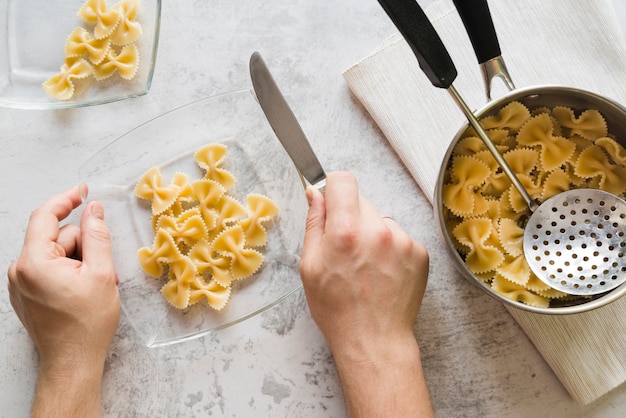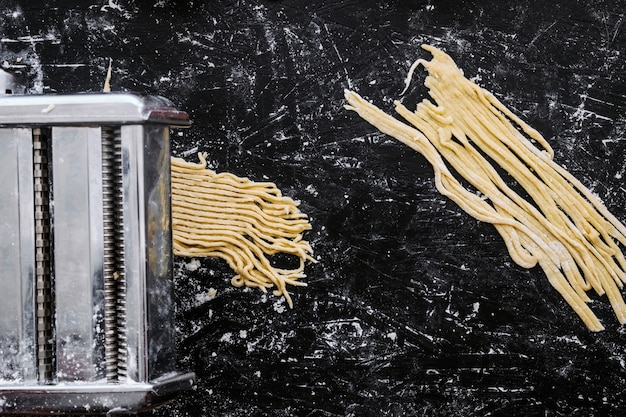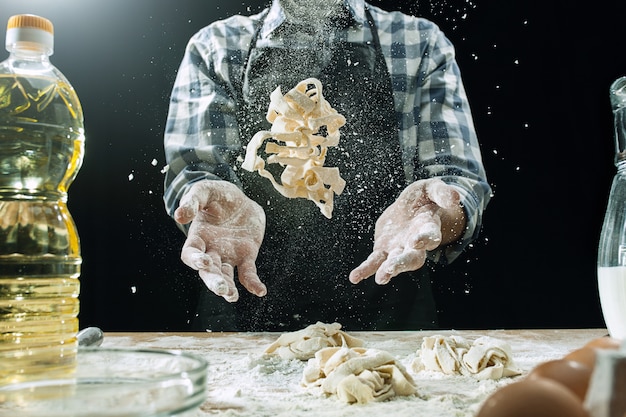Spaghetti. Just the name conjures up images of long, golden strands coated in a rich, flavourful sauce, a dish that's both comforting and utterly satisfying. I've been making spaghetti for years, and I've learned that it's a dish that's as simple as it is rewarding. But like any good chef, I've discovered there are a few key secrets to unlocking the potential of this classic Italian dish.
(Part 1)
The Foundation: Choosing the Right Spaghetti

Let's start with the basics: the spaghetti itself. It's not just about grabbing the first box you see. It’s about choosing the right spaghetti to match your taste and desired texture.
The Shape: A Matter of Taste
Think of spaghetti as a blank canvas, and the shape is your first brushstroke. For me, it’s always classic round spaghetti, the kind you've probably grown up with. It cooks evenly, holds its shape beautifully, and soaks up the sauce like a sponge. But if you want to step outside the box, there’s a whole world of spaghetti shapes to explore. Square-cut spaghetti gives you a slightly more substantial bite, while spaghetti alla chitarra (meaning "guitar string" in Italian) is thicker with ridges that beautifully capture the sauce. You can even find spaghetti with a slightly flattened shape. Ultimately, it comes down to personal preference, so go with what you think will taste best.
The Ingredients: Whole Wheat or Not?
Next, you need to choose between whole wheat and classic white spaghetti. Whole wheat spaghetti is packed with fiber and nutrients, but it can sometimes have a slightly more grainy texture and a milder flavor. Classic white spaghetti, on the other hand, is more refined, with a smooth, delicate texture that absorbs the sauce particularly well. It's a matter of personal preference, and depending on your dietary needs or taste, one may be a better choice than the other.
The Brand: A Matter of Quality
Now, this is a topic that can cause some debate, but in my opinion, the brand you choose really does make a difference. While the difference in price between the cheapest and the more premium brands might not seem substantial, it's a reflection of the quality of the ingredients and the way the pasta is made. A higher-quality brand will likely use durum wheat, which is known for its high gluten content, making for a firm texture that holds its shape during cooking. I've learned over the years that you definitely get what you pay for, so don't be afraid to invest in a good brand – you'll be rewarded with a more delicious and satisfying meal.
(Part 2)

The Secret Sauce: Mastering the Sauce

Now we’re getting to the real heart of the dish. A good spaghetti sauce is more than just a way to coat the pasta, it elevates the dish to a whole new level of deliciousness.
The Basics: Tomato, Tomato, Tomato
The foundation of any good spaghetti sauce is a robust, flavorful tomato base. You can buy a pre-made sauce, but for truly authentic and delicious results, I recommend starting with good-quality canned tomatoes. I’m talking about those plump, whole peeled tomatoes with a deep red colour and a rich, intense flavour. Avoid the cheap, watery ones – they won't give you the same depth of flavour.
The Flavour Boosters: Herbs and Spices
Once you have your tomato base, you need to add some flavour. Think of it like an orchestra: you need a variety of instruments to create a harmonious symphony. I like to use a mix of fresh herbs like basil, oregano, and parsley, along with a pinch of garlic, a sprinkle of red pepper flakes for a touch of heat, and a dash of salt and pepper to season it all. But don't be afraid to experiment! Try different combinations of herbs and spices - the possibilities are endless.
The Texture: A Matter of Choice
When it comes to texture, there’s a lot of room for personal preference. You can keep it smooth and velvety or add some extra texture with diced vegetables like onions, carrots, or celery. I personally love a chunky sauce, with plenty of chopped tomatoes and a few diced vegetables to add a bit of bite.
(Part 3)
The Art of Cooking: Al Dente Perfection
Now that we've got the spaghetti and the sauce sorted, it's time to get cooking. And the key here is to master the art of al dente cooking.
The Boiling Point: Getting it Right
The first step is to bring a large pot of salted water to a rolling boil. Salt is essential here – it adds flavour to the spaghetti and helps it cook evenly. I usually add about a tablespoon of salt per gallon of water.
The Time is Ticking: Finding That Sweet Spot
The timing is crucial. You want to cook the spaghetti until it’s al dente, which means it should have a slight bite to it. Don’t overcook it – that will turn it into a mushy mess. The cooking time will vary depending on the thickness of the spaghetti, but generally, it takes around 8-10 minutes.
The Test: Al Dente or Not?
To test if the spaghetti is al dente, take a strand out of the pot and bite into it. It should be cooked through but still have a little bit of resistance. If it feels mushy, it needs more cooking time. If it’s too firm, it needs to cook a bit longer.
(Part 4)
The Finishing Touches: Bringing it All Together
The sauce is simmering, the spaghetti is al dente, and now it’s time to bring it all together. This is where the real magic happens, and the finishing touches make all the difference.
The Drain: Less is More
When the spaghetti is cooked, drain it immediately, but don’t drain it completely. You want to keep a bit of the pasta water in the pot. This starchy water is called "pasta water" and it will help the sauce cling to the spaghetti and create a beautiful, creamy texture.
The Toss: A Symphony of Flavours
Now, it’s time to toss the spaghetti with the sauce. This is where the real artistry comes in. You want to gently toss the spaghetti in the sauce, making sure that every strand is coated evenly. Don’t overwork it – you want the spaghetti to retain its al dente texture.
The Garnish: A Finishing Touch
And finally, it’s time to add the finishing touch. A sprinkle of freshly grated Parmesan cheese, a few torn basil leaves, or a drizzle of olive oil – the options are endless. Let your creativity run wild.
(Part 5)
The Feast: Time to Enjoy
Now, the moment of truth: it’s time to enjoy your masterpiece! But before you dig in, take a moment to appreciate your work. Look at that beautiful plate of spaghetti, glistening with sauce, the aroma filling the air, the vibrant colours. It’s a testament to your culinary skills.
The Serving: A Touch of Elegance
For me, a plate of spaghetti is more than just food. It’s an experience. I like to serve it on a beautiful plate, with a simple garnish of fresh basil and a sprinkle of Parmesan cheese. It’s about making the whole experience special, from the moment you see it to the moment you taste it.
The Tasting: A Sensory Delight
And then, the moment you’ve been waiting for: the first bite. You can feel the al dente texture of the spaghetti, the rich flavour of the sauce coating your tongue, the burst of freshness from the basil. It’s a symphony of flavours and textures, a true delight for the senses.
(Part 6)
Beyond the Basics: Variations and Innovations
Now, I know what you’re thinking: spaghetti is all well and good, but what about mixing things up? Don’t worry, the world of spaghetti is full of possibilities.
The Meat Lover's Delight: spaghetti bolognese
For those who love a good meat sauce, there’s always spaghetti Bolognese. This classic Italian dish is rich, flavorful, and packed with tender ground beef. It’s a true comfort food that’s sure to satisfy.
The Seafood Sensations: Spaghetti alle Vongole
If you’re feeling adventurous, try spaghetti alle vongole. This light and refreshing dish features fresh clams, garlic, olive oil, and a touch of white wine. It’s a perfect summer dish that’s full of flavour.
The Vegetarian Delight: spaghetti with pesto
And for vegetarians, there’s always spaghetti with pesto. This vibrant dish is made with a sauce of fresh basil, pine nuts, Parmesan cheese, and garlic. It’s a simple yet delicious option that’s perfect for a quick and easy meal.
(Part 7)
The Leftovers: A Second Chance for Deliciousness
One of the best things about spaghetti is that it's even better the next day. Leftovers get a bad rap, but they're a chance to enjoy your masterpiece all over again, and with a few simple tips, you can make them even better.
The Storage: Keep It Fresh
First things first, you want to store your spaghetti properly. I like to put it in an airtight container and keep it in the refrigerator. This will help to preserve its flavour and texture.
The Reheating: Bring Back the Magic
When you’re ready to reheat your spaghetti, don’t just nuke it in the microwave. This will make it mushy and dry. Instead, I recommend reheating it in a pan on the stovetop with a little bit of pasta water or broth. This will help to rehydrate the spaghetti and bring back its flavour.
(Part 8)
FAQs: Your Spaghetti Questions Answered
I know you have questions, so here are some answers to some common ones:
Q: How much spaghetti should I cook per person?
A: A good rule of thumb is to cook about 1/2 cup of dry spaghetti per person. But feel free to adjust this amount based on your appetite and how much sauce you’re using.
Q: Can I make the sauce ahead of time?
A: Absolutely! In fact, I recommend it. Spaghetti sauce tastes even better when it’s had a chance to sit for a few hours, allowing the flavours to meld together. You can make the sauce a day or two in advance and store it in the refrigerator.
Q: What if I don’t have all the ingredients?
A: Don’t worry, you can easily adjust the recipe to suit what you have on hand. You can use different herbs and spices, or even add some vegetables for extra flavour and texture. Get creative and have fun with it!
Q: How can I prevent the spaghetti from sticking together?
A: A little bit of olive oil can go a long way. Add a tablespoon or two of olive oil to the boiling water before adding the spaghetti. This will help to prevent it from sticking together and ensure that it cooks evenly.
Q: Can I freeze spaghetti?
A: You can freeze cooked spaghetti, but it’s best to freeze it with the sauce. Just make sure to let it cool completely before freezing it. When you’re ready to enjoy it, thaw it overnight in the refrigerator and reheat it on the stovetop.
The Final Word: Spaghetti is a Journey, Not a Destination
I’ve shared my tips and tricks with you, but remember, spaghetti is a journey, not a destination. There are no rules, just guidelines. Experiment, have fun, and create your own perfect spaghetti. Who knows, you might even come up with a new masterpiece.
Now, go forth and cook! And remember, the best spaghetti is the one you make with love.
Everyone is watching

Prime Rib Roast Cooking Time Chart: Per Pound Guide
Cooking TipsPrime rib roast. Just the name conjures images of lavish dinners, crackling fires, and hearty laughter. It’s ...

How Long to Bake Potatoes in the Oven (Perfect Every Time)
Cooking TipsBaked potatoes are a staple in my kitchen. They're incredibly versatile, delicious, and surprisingly easy to m...

Perfect Rice Every Time: The Ultimate Guide to Cooking Rice
Cooking TipsAs a self-proclaimed foodie, I've always been a bit obsessed with rice. It's the foundation of countless cuisi...

The Ultimate Guide to Cooking Asparagus: Tips, Techniques, and Recipes
Cooking TipsAsparagus. The mere mention of this spring delicacy conjures up images of vibrant green spears, crisp and burs...

Ultimate Guide to Cooking the Perfect Thanksgiving Turkey
Cooking TipsThanksgiving. Just the word conjures up images of overflowing tables laden with delicious food, the scent of r...
